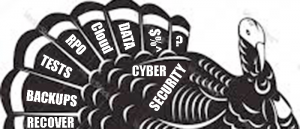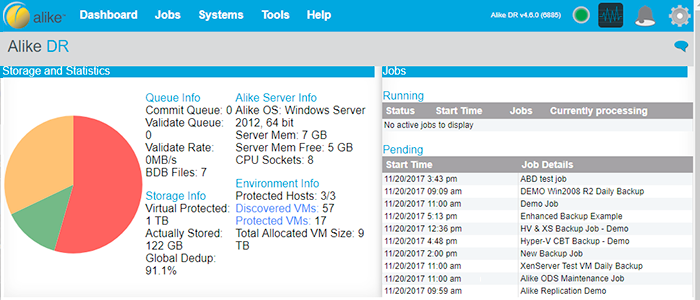Partner Spotlight – ShalevSoft
ShalevSoft is your trusted source for business software

We’d like to start this post off by saying we’re huge Bob’s Burgers fans here at Quadric, in case you haven’t noticed from our social media posts. As Disaster Awareness Month continues and Thanksgiving approaches, we can’t help think about all the turkey day disasters that Bob has seen over the seasons.
While Bob can’t afford to lose a turkey to sleepwalking fiascos, cyclops turkeys, or just your everyday, run-of-the-mill holiday disaster, neither can IT Departments afford to lose data during a holiday.
That said, we’ve also been thinking about how those of us who work in IT are always on call, even when we get a few days off for a special occasion. And disasters, turkey-related or not, can happen at any time. While we recognize that Thanksgiving is not a holiday celebrated by everyone reading this post, this scenario could happen over any holiday or long weekend…
You finally got a few well-deserved days off, and you’ve just arrived at your holiday destination, or perhaps you’ve planned a big Thanksgiving meal at your house, and you’re about to sit down to spend some time with family and friends.
Then suddenly, you get an email letting you know that all the systems are down, and you know that you need to take care of it ASAP. But let’s say you are far from the office, and you need to take care of the issue remotely. What do you do to avoid this, or at least mitigate the stress of the situation?
You can prevent major disasters before you even leave for the holiday with a little preparation. This starts with having a checklist to ensure the health of your environment, and a plan for when things do go wrong. Your checklist will obviously depend on your specific environment and business continuity needs. Regardless, disaster preparedness starts with the following checklist:
Having a sufficient number of backups, or even scheduling additional backups will help put you at ease during your holiday break. Be sure that the number of backups and replication jobs match your company’s RPO and RTO. See this blog post for more info how often you should backup according to your business’s business continuity needs.
Additionally, make sure your backup software is updated, and that you are using the best hardware available and that your system is set up according to best practices.
With Alike, it’s easy to schedule jobs or edit existing jobs. Whether you’re using Citrix XenServer, Microsoft Hyper-V, or you have a mixed environment, you can set up backup jobs in just a few clicks.
If you’re new to Alike, check out our post on best practices for initial backups to help get you started.
It’s also easy to make sure that you are using the web console.

Make sure you can easily monitor your systems with a glimpse of their progress, as you can in the Alike Dashboard above. Quickly gather data on the job queue, the Alike server, available storage, and the health of your environment.
There are additional graphs and specific data for each of your protected systems, which you can access by going to Systems -> Protected Systems, and clicking on the system you want more details for.

You’ll also want to make sure that your backup solution has plenty of notification options and that those are set up accordingly.
But first, it will help you save time in the end if you understand the appropriate thresholds for your systems. Knowing what these limits are (e.g. your RPO and RTO as mentioned in item #1) will help you avoid false alarms that can lead to ignoring alerts when they are real. Set up your notifications so that you receive emails only if there’s a real issue, especially during the holidays!
Alike also also provides the option to receive email notifications when a job completes, or only if problems are encountered. You can set those up accordingly when you create a new job.
Plus, in Alike’s Systems Settings under Tools, you will find the quick and simple steps to setting up email notifications for all of your jobs. For MS Exchange users, check out this post on setting up email notifications with Exchange.
We’ve talked about this a lot during Disaster Recovery Month here at Quadric. Rather than beat a dead server, we’ll just direct you to the following articles with more detailed information and instructions on this topic, starting with the most recent:
Offsite Vaulting As Part of a Healthy DR Plan
Do’s and Dont’s of Disaster Recovery
4 Things You Should Know About Disaster Recovery Planning: Part I
4 Things You Should Know About Disaster Recovery Planning: Part II
If you are using a backup solution that offers technical support, it’s also important that you have access to troubleshooting guides and understand how to use their tech support system and their emergency policy for tech support services.
How many times does your company or place of business perform fire drills? What if the alarms or sprinkler system didn’t work during a scheduled drill? The fire department would report this to your building manager immediately and determine the source of the problem so that it can be resolved ASAP. Your backup and disaster recovery plan should be no different.
First, you should make sure you know what to do in the event of a disaster. Then, make sure all of the appropriate team members are aware of the protocol you have designed or helped design. Then, make sure your BDR plan is up to date with frequent “health checks,” and be prepared for anything – from rebooting a VM to a full system restore.
Lastly, be sure you can do all of this from a remote location in case you are not able to get to your physical environment, or worst case scenario, your physical environment no longer exists due to a fire or other disaster.
Since we’re on the topic, we would like to remind everyone that our offices will be closed from Thursday, November 23rd and Friday, November 24th for the holiday. We will resume our regular business hours at 8:00am EST on Monday, November 27th.
On that note, we want to wish you a very happy and uneventful Thanksgiving from everyone here at Quadric!